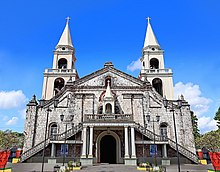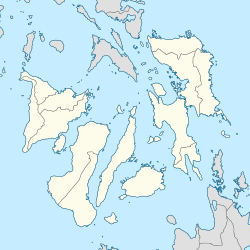Jaro Cathedral
This article needs additional citations for verification. (October 2012) |
| Jaro Cathedral | |
|---|---|
| Jaro Metropolitan Cathedral National Shrine of Our Lady of the Candles | |
 The façade of the Cathedral with the stairs leading to the National Shrine of Our Lady of the Candles. | |
 Jaro Cathedral Location in Visayas | |
| 10°41′24″N 122°33′0″E / 10.69000°N 122.55000°ECoordinates: 10°41′24″N 122°33′0″E / 10.69000°N 122.55000°E | |
| Location | Jaro, Iloilo City, Iloilo |
| Country | Philippines |
| Denomination | Roman Catholic |
| Website | [1] |
| History | |
| Status | Cathedral |
| Founded | 1587 (Parish of Jaro) |
| Dedication | Our Lady of the Candles Saint Elizabeth of Hungary |
| Consecrated |
|
| Relics held | Saint Josemaría Escrivá |
| Architecture | |
| Functional status | Active |
| Heritage designation | National Historical Landmark |
| Designated | 1976 |
| Architectural type | Metropolitan Cathedral and National Shrine |
| Style | Romanesque Revival |
| Completed |
|
| Specifications | |
| Number of domes | 1 |
| Number of spires | 3 |
| Administration | |
| Archdiocese | Archdiocese of Jaro |
| Clergy | |
| Archbishop | Archbishop Jose Romeo O. Lazo, D.D |
| Rector | Very Rev. Msgr. Jose Marie Amado S. Delgado, P.C. |
Jaro Cathedral, formally known as Jaro Metropolitan Cathedral and the National Shrine of Our Lady of the Candles (Spanish: Santuario Nacional de Nuestra Señora de la Candelaria), is the seat of the Roman Catholic Archdiocese of Jaro. It is located in the district of Jaro in Iloilo City, Iloilo, on the island of Panay in the Philippines. It was placed under the patronage of Saint Elizabeth of Hungary.[1]
The Catholic Bishops' Conference of the Philippines formally declared the cathedral the National Shrine of Our Lady of the Candles (Nuestra Señora de la Candelaria) on February 2012. The Cathedral is the second national shrine in the Visayas and Mindanao, the first being the Basilica del Santo Niño in Cebu. Likewise, it is also the first and only Marian dedicated declared "National Shrine" church or cathedral in Visayas and Mindanao.[2]
The statue of Nuestra Señora de la Candelaria (Candelaria) perched atop the façade of the cathedral, is the first Marian image canonically crowned personal by a Pope and Saint (John Paul II) in the Philippines and Asia. Also, through the said canonical crowning, the Nuestra Señora de la Candelaria has been declared as the official Roman Catholic patron of Western Visayas and Romblon
History[]
Along with the boom of the sugar industry of the Philippines especially centered in Iloilo, several churches and schools are constructed in Jaro.[3] The present cathedral structure was finished in 1874 by the first Bishop of Jaro, Mariano Cuartero, O.P. It was destroyed by the January 1948 Lady Caycay earthquake and later repaired in 1956 by the first Archbishop of Jaro, José María Cuenco.
The Marian image of Our Lady of the Candles also has the distinction of being canonically crowned personally by Pope John Paul II during his visit to Iloilo City on February 21, 1981, making it as the only Marian figure to be given such stature in the Philippines.[4]
The journalist, national hero, and co-founder of the Propaganda Movement, Graciano López Jaena, was baptized in the cathedral on December 20, 1856.
The National Historical Institute of the Philippines declared the Jaro Cathedral an historical landmark in 1976.[5]
In January 2012, the Catholic Bishops' Conference of the Philippines approved the cathedral as the National Shrine of Our Lady of the Candles, the first Marian-dedicated church or cathedral to receive such status in Visayas and Mindanao.[6]
The current parish priest/cathedral rector is Msgr. Jose Marie Amado Delgado.
Architecture[]
The shrine is constructed in the Romanesque Revival style, deviating from semi-circular arches. A distinctive feature is that the bell tower is located across a busy street from the church, on Jaro Plaza,[7] resembling Ilocos churches.[citation needed] Typically, belfries are built next to their churches. In this case, the tower was adjacent to an earlier church, but an earthquake destroyed the church and left the tower. Another distinctive feature is the stairs attached to the front facade of the cathedral, over the main entrance, leading up to a shrine featuring a statue of Our Lady of the Candles, as can be see in the picture at the top of this article. The church also possesses relics of St. Josemaría Escrivá.[8]
Another feature of the church is its all-male ensemble of saints placed on the main pillars, with the exception of the Virgin's icon. The arrangement is in response to Molo Church's all-female theme.[9]
On the cathedral grounds are several archdiocesan and parish offices, and a perpetual adoration chapel. About a block away is the archdiocesan seminary, St. Vincent Ferrer Seminary, and across the plaza is the archbishop's palace.
Gallery[]

Jaro Cathedral at night

Northeast façade of the cathedral.

Close-up view of the detached belfry

Chapel of Lights (Capilla de Luces)

Shrine of Our Lady of Candles located on the cathedral balcony

View of the altar

View of the cathedral nave

Northern flank of the cathedral

National Historical Institute marker
See also[]
- Crowned Marian images in the Philippines
References[]
- ^ "Jaro Cathedral and Belfry".
- ^ "Nat'l shrine declaration for Jaro cathedral | Inquirer News".
- ^ "Archived copy". Archived from the original on 2014-10-09. Retrieved 2014-10-16.CS1 maint: archived copy as title (link)
- ^ http://www.businessmirror.com.ph/index.php/en/lifestyle/tourism/29802-2014-03-30-12-33-28
- ^ "Cathedral of Jaro, Iloilo". Retrieved 2010-05-01.
- ^ "CBCP News Service".
- ^ See Jaro Belfry across Plaza Rizal Street on this map
- ^ "Iloilo".
- ^ "Jaro's Nuestra Señora de la Candelaria: A Mother to all Ilonggos".
External links[]
| Wikimedia Commons has media related to Jaro Cathedral. |
- Roman Catholic cathedrals in the Philippines
- Roman Catholic churches in Iloilo
- Spanish Colonial architecture in the Philippines
- Romanesque Revival church buildings
- Buildings and structures in Iloilo City
- Tourist attractions in Iloilo City
- Roman Catholic national shrines in the Philippines










